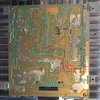1996 Ford Taurus/JBL Rear Control Unit F6DF-18C851-EF:
4ch out amp with discrete ST 70023AB amp ICs (F5VF-14A608-JD/PWB4082)
Logic board w/ Integrated Control Panel/cassette/CD inputs, output to powered sub
Digital AM/FM tuner
Background: Ever since I bought it (on eBay), the right-rear speaker would "POP" loudly when I turn it on, it would then immediately produce sound before the other speakers, but would sound perfectly groovy afterwards, untill I turned it off and heard "POP" again...Turned out (so I thought) to be a bad solder joint on pin 11 of the IC, used to control the on/off mute.
Where now: After that fix, I'm getting a much quieter pop, and it seems delayed. But the actual sound starts when its supposed to.
Now, I have a basic understanding of circuits and components, but I can't make sense of it all. The power and control circuitry seems to be shared between all the ICs, and Id hate to take off every singe cap just to test it. I did swap two ICs to see if that was the problem...it wasn't. I hastily checked all the resisters and diodes and they seem fine, I also swapped logic boards in this and my backup amp (80w MACH), it seems to be the JBL amp.
This model is pretty rare, I've spent 3 years getting the whole '96 JBL set together, so Junkyarding might not yield me much...
4ch out amp with discrete ST 70023AB amp ICs (F5VF-14A608-JD/PWB4082)
Logic board w/ Integrated Control Panel/cassette/CD inputs, output to powered sub
Digital AM/FM tuner
Background: Ever since I bought it (on eBay), the right-rear speaker would "POP" loudly when I turn it on, it would then immediately produce sound before the other speakers, but would sound perfectly groovy afterwards, untill I turned it off and heard "POP" again...Turned out (so I thought) to be a bad solder joint on pin 11 of the IC, used to control the on/off mute.
Where now: After that fix, I'm getting a much quieter pop, and it seems delayed. But the actual sound starts when its supposed to.
Now, I have a basic understanding of circuits and components, but I can't make sense of it all. The power and control circuitry seems to be shared between all the ICs, and Id hate to take off every singe cap just to test it. I did swap two ICs to see if that was the problem...it wasn't. I hastily checked all the resisters and diodes and they seem fine, I also swapped logic boards in this and my backup amp (80w MACH), it seems to be the JBL amp.
This model is pretty rare, I've spent 3 years getting the whole '96 JBL set together, so Junkyarding might not yield me much...

